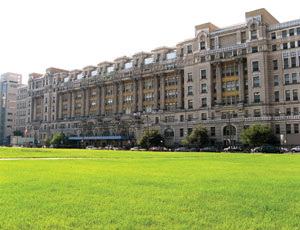The hospital that served as the model for television’s long-running medical drama “ER” will soon get a new lease on life. Chicago’s 96-year-old Cook County Hospital, vacant since 2002, is about to receive a $108-million renovation that will turn the historic building into administrative offices for the local health-care sector.

The two-block-long building has been idle since 2002, when it was replaced by the new John H. Stroger Jr. Hospital, located nearby on the same grounds. After the planned renovation, the old building will house administrative offices for the Cook County Health and Hospitals System. Staff currently work in a converted dormitory, which will be razed.
Cook County’s Bureau of Capital Planning and Facilities Management expects to select designers and engineers for the project in the next two to three months, according to Anna Ashcraft, the bureau’s special assistant for legal affairs. The county usually tackles major projects through traditional design-bid-build, Ashcraft adds. The entire renovation is expected to take about three years.
The green light to rework the 309,000- sq-ft, eight-story building with its ornate, Beaux-Arts facade came when Cook County commissioners approved a redevelopment plan on March 2.
Examining the Patient
Planners studied different uses for the historic building. Based on layout, cost, need and market conditions, the plan, developed by Chicago-based Jones Lang LaSalle (JLL), says office space is the best use. “This is a fantastic opportunity for redeveloping a landmark building,” says Joseph Caprile, architect and vice president of JLL. “The integrity of the historic exterior will be maintained, while the interior will be completely renovated into a contemporary office building.”
The old and new hospitals bookend a circle drive in the Illinois Medical District on Chicago’s West Side. In its feasibility study, JLL examined turning the old hospital into rental offices, a hotel, a dormitory, rental housing, senior housing or an educational facility. All mechanical, electrical, plumbing, vertical transportation and other systems will be new, Caprile says. “This gives the designer a chance to start absolutely fresh and figure out how modern systems can be fit into the existing shell,” he notes.
The renovations also will aim at making the building as energy-efficient as possible, Ashcraft says. Cook County requires that new construction or capital improvements to county-owned buildings be designed and built to the standards of the U.S. Green Building Council’s LEED rating system.
The renovation will require $18.1 million in facade work, $39.1 million of core-and-shell work, $24.4 million of interior build-out, $600,000 on retail space, $700,000 on day-care space and about $24.9 million in soft costs, reports JLL.
The project is eligible for Tax Increment Financing from the city. The amount will be negotiated between the city and county, and bonds are expected to finance the remainder. Construction will start after the county board approves the final financing arrangements.
Making Medical History
A few years ago, this planned transformation wasn’t thinkable: After the new hospital opened, the county planned to raze the old building. Preservationists intervened by getting it on the National Register of Historic Places. Not only does its terra-cotta facade serve as an example of period architecture, its interior was home to many medical achievements over the past 100 years.
“Cook County Hospital tells the story of public medicine in the 20th Century,” says Jonathan Fine, executive director of Preservation Chicago, one of the groups that advocated for the rehab. “It was a pioneering teaching hospital, and it was the first in the world with a blood bank, first in the country with a burn unit, first with a trauma center, first with an AIDS unit and first with a sickle-cell anemia unit.” Fine also says that in decades long past, it was one of a few places African-American doctors could train.
An ENR exclusive video about the project is available online at www.construction.com/video.


Post a comment to this article
Report Abusive Comment